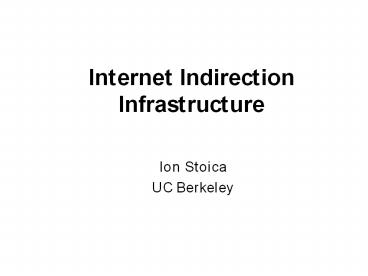Internet Indirection Infrastructure PowerPoint PPT Presentation
Title: Internet Indirection Infrastructure
1
Internet Indirection Infrastructure
- Ion Stoica
- UC Berkeley
2
Motivations
- Todays Internet is built around a unicast
point-to-point communication abstraction - Send packet p from host A to host B
- This abstraction allows Internet to be highly
scalable and efficient, but - not appropriate for applications that require
other communications primitives - Multicast
- Anycast
- Mobility
3
Why?
- Point-to-point communication ? implicitly assumes
there is one sender and one receiver, and that
they are placed at fixed and well-known
locations - E.g., a host identified by the IP address
128.32.xxx.xxx is located in Berkeley
4
Key Observation
- Virtually all previous proposals use indirection,
e.g., - Physical indirection point ? mobile IP
- Logical indirection point ? IP multicast
5
Our Solution
- Use an overlay network to implement this layer
- Incrementally deployable dont need to change IP
6
Internet Indirection Infrastructure (i3)
- Each packet is associated an identifier id
- To receive a packet with identifier id, receiver
R maintains a trigger (id, R) into the overlay
network
Sender
Receiver (R)
7
Service Model
- API
- sendPacket(p)
- insertTrigger(t)
- removeTrigger(t) // optional
- Best-effort service model (like IP)
- Triggers periodically refreshed by end-hosts
- ID length 256 bits
8
Mobility
- Host just needs to update its trigger as it moves
from one subnet to another
Sender
9
Multicast
- Receivers insert triggers with same identifier
- Can dynamically switch between multicast and
unicast
id
R1
Receiver (R1)
Sender
id
R2
Receiver (R2)
10
Anycast
- Use longest prefix matching instead of exact
matching - Prefix p anycast group identifier
- Suffix si encode application semantics, e.g.,
location
Receiver (R1)
R1
ps1
R2
ps2
Sender
Receiver (R2)
R3
ps3
Receiver (R3)
11
Service Composition Sender Initiated
- Use a stack of IDs to encode sequence of
operations to be performed on data path - Advantages
- Dont need to configure path
- Load balancing and robustness easy to achieve
Transcoder (T)
Receiver (R)
Sender
id
R
idT
T
12
Service Composition Receiver Initiated
- Receiver can also specify the operations to be
performed on data
Firewall (F)
Receiver (R)
Sender
idF
F
id
idF,R
13
Quick Implementation Overview
- ID space is partitioned across infrastructure
nodes - Each node responsible for a region of ID space
- Each trigger (id, R) is stored at the node
responsible for id - Use Chord to route triggers and packets to nodes
responsible for their IDs - O(log N) hops
14
Example
- ID space 0..63 partitioned across five i3 nodes
- Each host knows one i3 node
- R inserts trigger (37, R) S sends packet (37,
data)
8..20
4..7
42..3
21..35
Sender (S)
36..41
Receiver (R)
15
Optimization Path Length
- Sender/receiver caches i3 node mapping a specific
ID - Subsequent packets are sent via one i3 node
8..20
4..7
42..3
21..35
Sender (S)
36..41
Receiver (R)
16
Optimization Triangular Routing
- Use well-known trigger for initial rendezvous
- Exchange a pair of (private) triggers
well-located - Use private triggers to send data traffic
8..20
4..7
42..3
21..35
Sender (S)
36..41
Receiver (R)
17
Outline
- Overview
- Security
- Discussion
18
Some Attacks
Eavesdropping
R
id
R
S
19
Constrained Triggers
- hl(), hr() well-known one-way hash functions
- Use hl(), hr() to constrain trigger (x, y)
20
Attacks Defenses
Trigger constraints Pushback Trigger challenges Public i3 node constraints
Eavesdropping Impersonation
Loops Confluences
Dead-ends
Reflection Malicious trigger-removal
Confluences on i3 public nodes
Attack
Defense
21
Outline
- Overview
- Security
- Discussion
22
Design Principles
- Give hosts control on routing
- A trigger is like an entry in a routing table!
- Flexibility, customization
- End-hosts can
- Source route
- Set-up acyclic communication graphs
- Route packets through desired service points
- Stop flows in infrastructure
- Implement data forwarding in infrastructure
- Efficiency, scalability
23
Design Principles (contd)
Infrastructure
Host
Data plane
Internet Infrastructure overlays
Control plane
p2p End-host overlays
Data plane
Control plane
i3
Data plane
Control plane
24
Example Application Specific Routing
A
Network measurements
Query/reply routing info.
Setup routes
B
D
C
25
Conclusions
- Indirection key technique to implement basic
communication abstractions - Multicast, Anycast, Mobility,
- This research
- Advocates for building an efficient Indirection
Layer on top of IP - Explore the implications of changing the
communication abstraction already done in other
fields - Direct addressable vs. associative memories
- Point-to-point communication vs. Tuple space (in
Distributed systems)
26
Status
- i3 available as a service on Planetlab
- Support for legacy applications in Linux and
Windows XP - Current applications
- Mobility
- Transparent access to machines behind NATs
- Secure and transparent access to services behind
firewalls - Please come see the demo posters!

